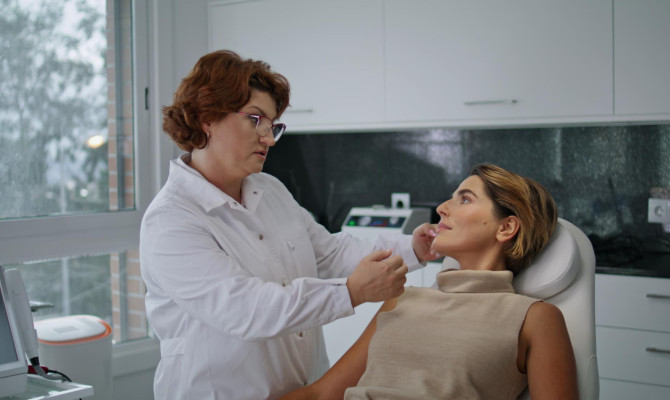All About Anemia : An Overview

- Anemia
- 14 Aug 2023
Overview
What is Anemia ?
Anemia is a condition that occurs when the body does not have enough red blood cells or those that are present in the body are unable to function properly.
Red blood cells carry hemoglobin. Hemoglobin is a protein that attaches to the oxygen in the lungs and carries it to all parts of the body. When the number of red blood cells or hemoglobin goes down, a sufficient amount of oxygen cannot be transported throughout the body. As a result, it cannot function properly. It could present itself as a mild, short-term condition, or as a lifetime problem. It may be life-threatening if left untreated.

Vulnerability
Who is at Risk?
Anemia is a serious public health problem worldwide. One-third of the global population is affected by anemia10Risk| Researched based study from Nlm.nih.gov , as it is an extremely popular disease. It frequently exhibits modest symptoms and needs no treatment.
There are several risk factors like:
- Age – Children, less than 5 years of age, and older individuals have a higher risk. 1who is at risk? | Researched based study from nih.gov
- Gender – women are more prone to anemia than men, especially women of reproductive age, pregnant women, breast-feeding mothers, women nearing menopause. 40% of pregnant women globally, are anemic. 2who is at risk?| Researched based study from who.int
- Socio-economic condition – The disease burden of anemia is most in low and middle-income countries. The burden of anemia is the highest in Sub-Saharan Africa with also South Asia being heavily affected. 3Who is at risk?| Researched based study from Nih.gov
- Chronic illness – liver disease, thyroid problems, kidney disease, rheumatoid arthritis or other autoimmune disorders or any type of cancer.
- Nutritional deficiency – Most common in elderly patients. Folate, iron and vitamin B12 deficiency. Some vegetarians seem to develop a vitamin B12 deficiency, causing megaloblastic anemia.
- Alcohol- chronic alcoholism increases the risk.
- Prolonged medications – for chronic illnesses may put a person under risk.
- Frequent blood donations – might result in decreased red blood cell count, but this is not permanent. If they are otherwise healthy and do not have a history of anemia, then one need not worry.
- Digestive problems – having intestinal disorders or a digestive condition called Crohn’s disease, or if a part of the stomach or small intestine gets removed as a treatment measure may increase the risk of developing anemia.
Types
Types of Anemia
There are many types of anemia and all of them decrease the number of red blood cells. Based on the cause of anemia, it could be categorized into a few types as follows,
Anemia due to nutritional deficiencies
Iron deficiency anemia
- The most common type of anemia worldwide.
- The body does not have enough iron to produce enough hemoglobin.
- Could be due to inadequate intake of iron in food, or because of the inability to absorb iron, or due to excess blood loss.
- Dietary requirement of mineral iron-8.7mg per day, for a man over 18 years of age,14.8 mg of iron per day for a woman aged between 19 to 50 years, and 8.7 mg a day if it is a woman above 50 years of age. 4types of anemia| Researched based study from nhs.uk
Megaloblastic type
- The body does not get enough Vitamin B12, folate, or both from the consumed food. Mostly occurs in vegetarians.
Pernicious type
- The body gets enough vitamin B12 from the diet but is unable to absorb it.
Anemia due to bone marrow & stem cell problems
- Macrocytic – the bone marrow produces red blood cells unusually larger in size.
- Microcytic – the bone marrow produces unusually smaller red blood cells.
- Normocytic – the body has unusually fewer red blood cells but those red blood cells lack a normal amount of hemoglobin.
- Sideroblastic – when there is too much iron in the system, but not enough red blood cells.
- Hemolytic – when the red blood cells die unusually faster.
- Autoimmune hemolytic anemia – it is an autoimmune condition, where the immune system mistakes red blood cells for foreign bodies and starts destroying them.
- Aplastic type – the bone marrow stem cells produce very less or no red blood cells at all.
- Anemia due to lead poisoning- Lead is toxic to the bone marrow and too much exposure can interfere with red blood cell production and cause anemia.
Anemia due to inheritance
- Sickle cell type – the hemoglobin becomes abnormal to form something called hemoglobin-S, which gives sickle shape to the red blood cells. As a result, the red blood cells can only carry lesser oxygen to the cells.
- Fanconi anemia – A very rare type of inherited anemia, where the bone marrow produces unhealthy blood cells and platelets. People with Fanconi anemia are at more risk of developing bone marrow failure, blood disorders like aplastic anemia, and myelodysplastic anemia, and 10% of them, might even develop cancer like leukemia.
- Diamond black-fan anemia – It is a very rare genetic blood disorder, where certain genes mutate. It affects the bone marrow, preventing it from producing red blood cells.
- Thalassemia – the red blood cells are really small, but the body could be making enough of them to remain asymptomatic. Rarely, it could be severe too.
Symptoms
Signs and symptoms
Normal Hemoglobin values are as follows:
- 13.5 to 18 g/dL in men
- 12 to 15 g/dL in women
- 11 to 16 g/dL in children
Most patients start showing some symptoms related to anemia when the hemoglobin level falls below 7 g/dL. 5Signs and symptoms | Researched based study from nih.gov
There are certain symptoms, specific to the type of anemia.
People with iron deficiency anemia might show symptoms like
- Tiredness
- Headache
- Weakness
- Diarrhea
- Chest pain
- Fast heartbeat
- Cold hands and feet
- Shortness of breath
- Poor appetite in children
- Dizziness or lightheadedness
- Brittle nails – a classic symptom
- Unusual cravings in children – ice or dirt
People with Megaloblastic anemia show symptoms like
- Diarrhea
- Confusion
- Difficult to walk
- Problems with eyesight
- forgetting things easily
- swelling of the tongue – appearance of a smooth and red tongue
People with Aplastic anemia will show symptoms like
- Easy bruising
- Skin rashes
- Other common anemic symptoms
People with Hemolytic anemia show symptoms like
- Weakness
- Tiredness
- Abdominal pain
- Jaundice (yellowing of the mucous membranes, whites of the eye, and the skin)
- Dark urine
Causes
Causes of Anemia
The most common cause of anemia, worldwide is poor diet. Other causes are as follows:
- Family history – some types of anemia pass down through genes from one parent or both parents.
- Age – the chances of getting anemia increase with age.
- Socio- economic condition – People living in low socioeconomic conditions globally, may have anemia as a result of improper nutrition.
- Autoimmune disorders – Crohn’s disease, auto immune hemolytic anemia, rheumatoid arthritis, etc.
- Nutritional deficiencies – of folate, iron, vitamin B2, and vitamin B12 can cause anemia.
- Lifestyle habits – excessive alcoholism can cause anemia. People who do not eat healthy or a balanced diet with food rich in vitamin C, folic acid, vitamin B12, and iron may develop anemia.
- Blood loss – trauma / injury, childbirth, heavy menstruation in females, intestinal hook worm infestation may cause excess anemia induced by blood loss.
- Pregnancy & breastfeeding – mothers can develop anemia during pregnancy or during breastfeeding, if they do not consume highly nutritive food and iron supplements during pregnancy.
- Chronic illness – chronic kidney disease, and rheumatoid arthritis can cause anemia, heart failure may cause anemia.
- Medications – NSAIDs, immunosuppressants, and antibiotics or medications for chronic illnesses can cause anemia.
- Frequent blood donations – This does not happen if you donate your blood once in a while.
- Malaria – one of the primary causes of mild to moderate anemia, sometimes even severe anemia, worldwide. Especially in Sub-Saharan Africa, mainly West Sub-Saharan Africa, where malaria is the primary cause of 25% of all anemia cases. 6causes of anemia| Researched based study from ashpublications.org
- Schistosomiasis – similar to hookworm, also results in blood loss, mainly if the severity of the infection is high. 7causes of anemia| Researched based study from sciencedirect.com
- Chemotherapy & Radiation therapy – for cancer can disturb the bone marrow and cause decreased production of red blood cells, resulting in anemia.
- Infectious diseases – like HIV/ AIDS, endocarditis, tuberculosis infection, osteomyelitis (infection of the bone), hepatitis or liver failure may result in anemia.
- Environmental cause – excess exposure to toxins like pesticides, arsenic, lead, etc.
- Cancer like – Hodgkin disease, non-Hodgkin lymphoma, cancer of the lung, cancer of the breast, bone marrow cancer, etc. may cause anemia.
Prevention
Prevention of anemia
Anemia cannot be prevented if it is inherited from parents. if not inherited, it can be prevented to some extent as follows:
- Consume a proper nutrient-rich balanced diet.
- Take supplements like vitamin B12, vitamin C supplements if required.
- To prevent iron deficiency anemia in children, one can start introducing iron-rich food from 12 months of age.
- Pregnant women must take folic acid supplements and routine tests to prevent anemia.
- Women experiencing heavy blood loss during menstruation, must consult with a doctor immediately and start taking iron supplements to prevent developing anemia.
- Stay away from certain chemicals like lead, pesticides, etc.
- Get vaccinated to prevent severe infections.
- Maintain oral hygiene and visit the dentist regularly as iron deficiency anemia may be a reason for some dental problems as well.
- Maintain general hygiene and keep nails trimmed to avoid any intestinal worm infestation.
- Tracking the symptoms and contact the doctor whenever necessary.
- Exercise regularly.
- Stay hydrated.
Diagnosis
Diagnosis
Diagnosis may include few questions about the symptoms, medical history, family history, physical examination, blood tests, few other diagnostic tests as follows:
Physical examination:
- The doctor may also examine for signs of anemia like brittle nails, pale skin or tongue, yellowing or pale appearance of the mucous membranes, and the white of the eyes.
- Doctor may also check for any kind of murmur, any rapid or irregular heartbeat, rapid or uneven breathing with the stethoscope.
- Also check if the blood pressure suddenly falls when a person stands up.
- He/ She may feel the abdomen to check if there is any increase in the size of the liver or spleen.
- The doctor may also do a pelvic or rectal exam to check if there are any sources for the blood loss.
Blood tests:
- Complete blood count (CBC) – used to count the blood cells in the sample, check hemoglobin and hematocrit level and MCV (mean corpuscular volume)
- A peripheral blood smear – done to see if the red blood cells have taken up any abnormal shape.
- Serum iron and ferritin tests – done to check the amount of iron in the blood.
- A reticulocyte count – to see if the bone marrow is producing red blood cells at a much higher speed than usual. It indicates recent blood loss.
- Hemoglobin electrophoresis – to see if there are any abnormalities in the hemoglobin, which is usually present in thalassemia and sickle cell anemia.
- An osmotic fragility test – is taken to see if the red blood cells are weaker than usual.
Urine test:
- Urine tests are done to check if the kidneys are working properly.
- They can also tell whether there is any bleeding in the urinary tract.
Stool test:
- Stool tests checks the presence of blood in the stool sample.
Colonoscopy:
- to look for bleeding or problems like tumors in the intestines.
- The patient will be given medications to relax, and a small camera will be inserted into the anus to check the intestine directly.
Endoscopy:
- to look for any abnormal bleeding or growth in the food pipe, stomach, and the upper part of the small intestine.
- This involves inserting a tube with a tiny camera into the mouth, down to the stomach and upper small intestine.
Chest x-ray:
- Chest x-rays may be recommended to rule out any infections in anemia patients like tuberculosis.
A Magnetic Resonance Imaging (MRI) scan:
- is done to find problems with the bone and the bone marrow.
- It can also help evaluate the concentration of iron in the heart, liver, and other organs.
- MRI is very useful in patients with multiple blood transfusions.
CT of the Abdomen and pelvis:
- Uses x-rays to see the bones, lymph nodes, and internal organs.
- An enlarged spleen or enlarged lymph nodes can be detected by this.
- Also helps detect cancer.
Ultrasound:
- Ultrasound can find if there is any enlargement of the spleen or the presence of uterine fibroid without using radiation.
Bone marrow test:
- Done to check the overall health of the bone marrow and if it can produce a normal amount of blood cells as it should.
- Aspiration & biopsy are the two techniques by which bone marrow tests are done to evaluate bone marrow health.
- The samples will then be studied in a laboratory before you get the results.
Complications
Complications
Most people live normal and healthy lives after getting the appropriate treatment. However, if not diagnosed or left untreated for a prolonged period, anemia can cause moderate to life-threatening complications, as follows:
- In young children – developmental delays, behavioral problems and higher risk of lead poisoning.
- In pregnant women – premature labor or excessive blood loss 8complications | Researched based study from Sciencedirect.comduring delivery, newborns with birth defects or low birth weight, infant death, etc.
- In older population – complications are more due to comorbidities. 9complications | Researched based study from Nih.gov may affect cardiovascular system, resulting in heart attack and heart failure due to arrhythmia.
- Restless legs and the appearance of webs in the food pipe may be associated with severe iron deficiency anemia.
- Other infections – anemia could be fatal in individuals with a weakened
- Multiple organ failure and even death sometimes.
Treatment

Treatment options
Based on the diagnosis and severity of anemia, the treatment of anemia varies as follows:
- Iron deficiency anemia due to nutritional deficiency – modifications in the diet or supplements may help.
- Anemia due to vitamin deficiency – If there is a problem absorbing iron, Vitamin-C supplements may be needed. If there is a troubling absorbing vitamin-B12, the individual may need vitamin B12 supplements and sometimes, even injections.
- If the anemia is due to excess bleeding, the cause of the bleeding will have to be detected and stopped.
- Hormonal medications – may be recommended in women with heavy period.
- Antibiotics – given to treat infections that may be causing anemia.
- Blood transfusions – Patients with severe iron deficiency anemia, may need blood transfusions or even surgery.
- Anemia related to chronic disease – Treatment of the underlying disease may usually seem to be enough to improve anemia.
- Anemia related to autoimmune disorders – the doctor may need to suppress the immune system to prevent the immune system from attacking the blood cells.
- Hemolytic anemia – the doctor may prescribe immune suppressors to prevent red blood cell destruction. The patient may need blood transfusions, filtering of blood, and in extreme cases, spleen removal.
- Sickle cell anemia – Depending on the severity, one may need folic acid supplements, antibiotics to fight infections, oxygen therapies, blood transfusions, or even bone marrow transplants.
- Thalassemia – if it is mild, they may not need treatment. If it is found to be severe, blood transfusions, folic acid supplements, sometimes spleen removal, or a bone marrow transplant may help.
- Bone marrow problems – Erythropoietin shots can be given to help the bone marrow produce more red blood cells. In some cases, chemotherapy or a bone marrow transplant may be required.
- Aplastic anemia – Red blood cell level may be boosted with medications and blood transfusion. Bone marrow biopsy may be required to find the cause of anemia.
Takeaway
Take away points
Depending on the cause, severity, and the timing of medical intervention, anemia’s effects can range from minor discomfort to potentially fatal complications. Make an appointment with the doctor shortly if you experience any of the symptoms listed above. Communicate your symptoms with your doctor, ask about the available medical treatments, and what you may do at home to better your health.
Any feedback on this article?
 This Articles content was accurate
This Articles content was accurate Very Informative Article
Very Informative Article I have a question or a comment
I have a question or a comment
 This article contains inaccurate content
This article contains inaccurate content This article was not helpful
This article was not helpful I have a question or a comment
I have a question or a comment
We appreciate your helpful feedback!
Checkout our social pages
References
-
National Institutes of Health
Epidemiology of anemia in older adults/risk/Age
-
World Health Organization
Anaemia/Risk/Gender
-
National Institutes of Health
Anemia: a comprehensive global estimate/Risk/Socioeconomic factors
-
National Health Service
Iron-Vitamins and minerals/Anemia/deficiency
-
National Institutes of Health
Anemia/Normal Hemoglobulin values
-
ASH Publications
A systematic analysis of global anemia burden from 1990 to 2010/Causes
-
Science Direct
Human schistosomiasis and anemia: the relationship and potential mechanisms/Causes
-
Science Direct
Anemia and iron deficiency: effects on pregnancy outcome/Complications
-
National Institutes of Health
Anemia in the elderly: clinical implications and new therapeutic concepts/Complications
-
National Library of Medicine
Anemia | Risk



































